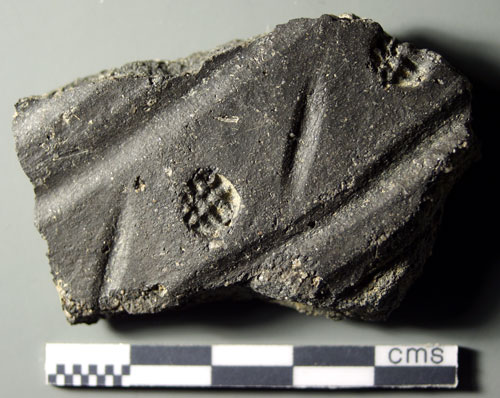
 |
Archive of Anglo-Saxon Pottery Stamps
|
Recording Anglo-Saxon Pot StampsThe late Dr J.N.L. Myres was the first person to suggest it would be possible to obtain information from pot stamps, other than as a pure decorative medium, in Antiquity (Vol. XI: 1937). Since the AASPS was set up in 1981, it has become possible not only to trace distribution of the less common types of motifs, but also to attribute them to specific areas, families or tribes. Thus what in the past was not considered of much use is now proving to be an important part of the understanding of the Anglo-Saxon peoples. The AASPS is always available for consultation, but most people working on stamps will consult local and national publications in the first instance. This makes accuracy in these sources extremely important. Motif Recording PolicyThe AASPS's policy for recording motifs is to treat every stamped sherd with a different museum number or context number as a separate example of the motif. There are occasionally examples where the decorative scheme makes it highly likely that two sherds are from the same urn, but unless the excavator has identified them as from the same urn, the AASPS will record the sherds as separate items. The possibility of the two sherds being from the same urn is recorded on the cards as an additional comment. Taking CastsThe suggested material is ‘DAS’ Pronto cold modelling clay, which is available from art dealers and some toy shops. If possible, cast two stamps of a group, as it is helpful to show how the group of stamps relates to the individual. (If the sherd is small, it is sometimes more satisfactory to take an impression of the whole sherd.) METHOD 7. If any of the clay is left on the pot or sherd, it can easily be removed with a wet sponge. Any pieces cut off and not used can be kneaded together and used again. The clay does not have harmful effect on the pot surface. The DAS cold clay will keep for a long time, providing that only small quantities are used at a time and the rest is stored in a plastic bag from which the air has been expelled and which is sealed with a tie. Please Note: The only exceptions are A 1ai and D 1ai stamps. Where these are found, please fill out a card, but don’t bother to cast it unless the stamp appears to be unusual. If in doubt, cast it. Drawing Anglo-Saxon Pot StampsThis can be done by two methods: Neither method is perfect, but the second is generally preferable, particularly for drawing concentric line stamps. If the first method is used, the depth shading is lost in publication and it is often impossible to tell the number of positive and negative circles a stamp may have and so compare it with other pots in the same cemetery, and with pots from other sites. These remarks apply equally to rectangular (C), triangular (E), diamond (F) and horseshoe-shaped (G) motifs with concentric lines. There are also times when it is not possible to show the depth of a stamp, or its shape (e.g. cone or pyramid) by the positive/negative method. In such cases, it is better to use the linear definition method. • Every motif should be illustrated and placed separately from the drawing of the pot. A particular hazard for illustrators is the 'rogue' stamp which may have been introduced at the end of a line of stamps or at the bottom of a chevron. Sometimes this is a stamp which appears to be of the same type and size as the others but, for example, a rosette stamp may have a different number of petals. The question of identical stamps has been investigated by Dr C. Arnold in some depth, and it has become evident that Anglo-Saxon potters must have owned several dies with the same motif, and in different sizes. However, stamps which appear to be visually identical, may show small differences in the cut of the die if examined by microscope.
|
Archive of Roman Pottery Stamps
|